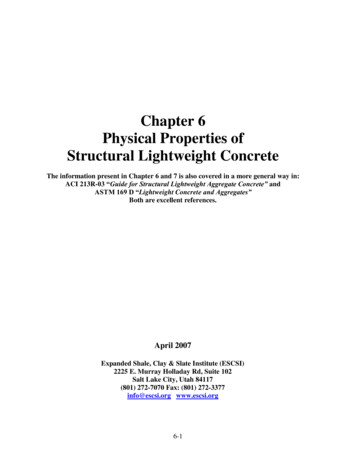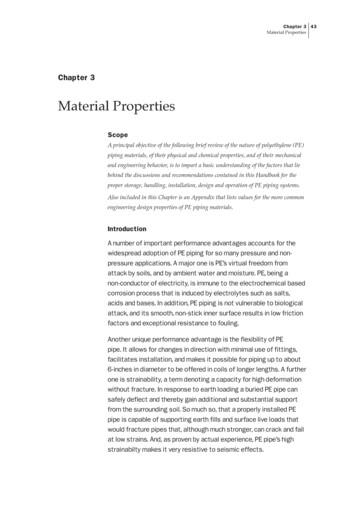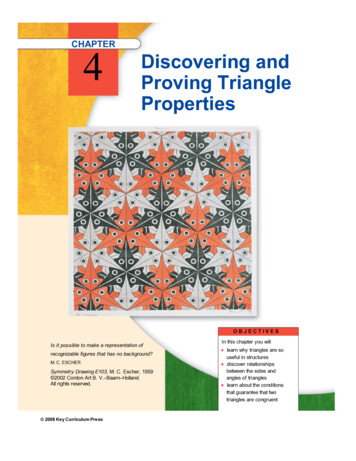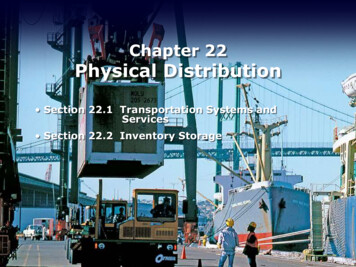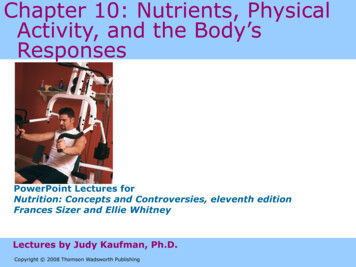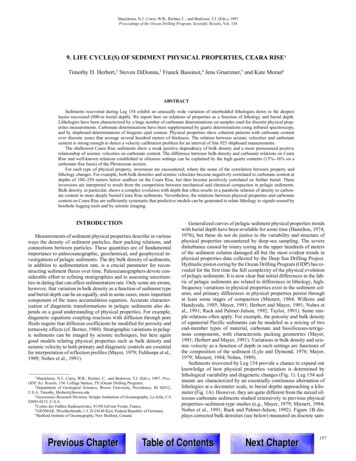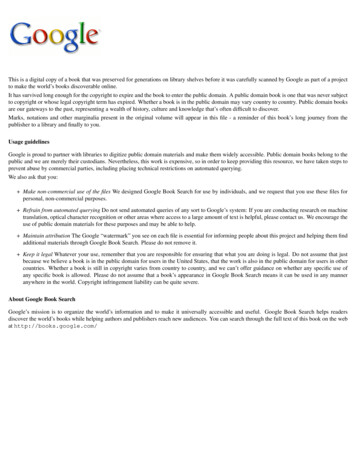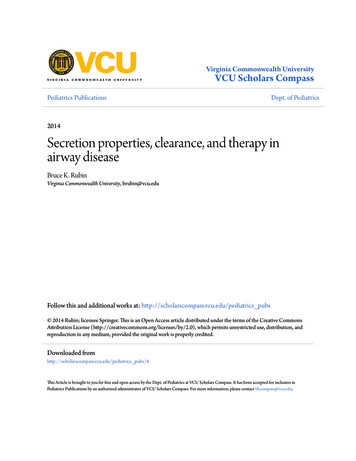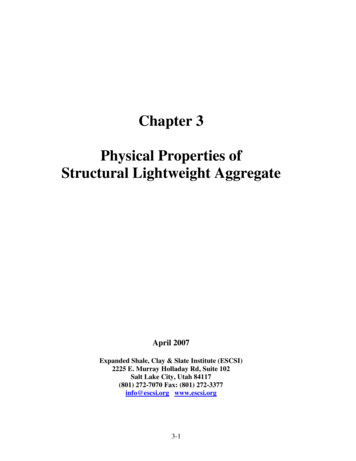
Transcription
Chapter 3Physical Properties ofStructural Lightweight AggregateApril 2007Expanded Shale, Clay & Slate Institute (ESCSI)2225 E. Murray Holladay Rd, Suite 102Salt Lake City, Utah 84117(801) 272-7070 Fax: (801) 272-3377info@escsi.org www.escsi.org3-1
CHAPTER 33.0Introduction3.1Definition of Lightweight AggregatesStructural Lightweight AggregateMasonry Lightweight AggregateInsulating Lightweight Aggregate3.2Particle Shape and Texture3.3Grading Lightweight Concrete Aggregate for Concrete3.4Relative Density of Aggregate Particles3.5Aggregate Bulk Density3.6Moisture DynamicsAbsorption CharacteristicsSaturated Surface DryStockpile Moisture ContentFull Saturation3.7Alkali-Silica Reaction in Lightweight ConcreteAppendix 3AAppendix 3BAppendix 3CAppendix 3DAppendix 3EAppendix 3FAppendix 3GAppendix 3HAppendix 3IAppendix 3JASTM C 330-05 ―Standard Specification For Lightweight Aggregate ForStructural Concrete”ASTM C 331-05 “Standard Specification For Lightweight Aggregates ForConcrete Masonry Units”ASTM C 332-99 “Standard Specification For Lightweight Aggregate ForInsulating ConcreteESCSI Worksheet for Calculating Aggregate Properties“Procedures For Determination of Density Factors of Structural LightweightAggregate”“Moisture Dynamics of Lightweight Aggregate and Concrete”, Holm, Ooi andBremner.“Water-Vapor Absorption-Desorbtion Characteristics of Selected LightweightConcrete Aggregates”, Landren, PCA Bulletin ’78.Pages 34-37, 153-155, Extracted from the ―Thermophysical Properties ofMasonry and its Constituents”, R.C. Valore, International Masonry Institute1988.ASTM C 1260-05a ―Test Method for Potential Alkali Reactivity of Aggregates(Mortar Bar Method)”.Chapter 46 ―Lightweight Concrete and Aggregates”, Significance of Tests andProperties of Concrete and Concrete-Making Materials, ASTM SpecialTechnical Publication 169D3-2
CHAPTER 3 - PHYSICAL PROPERTIES OF STRUCTURALLIGHTWEIGHT AGGREGATE3.0IntroductionThis chapter provides definitions, basic physical properties, ASTM Standards andSpecifications. The methodology for determining the fractional parts of an aggregateparticle, pores versus solids and interstitial voids in the bulk volume are shown. Howthese individual parts influence concrete moisture dynamics and aggregate absorptioncharacteristics are analyzed.This chapter provides specific terminology that is essential for a physicalunderstanding and methodical calculation of various degrees of saturation. Informationis also provided on alkali-aggregate reaction test methods and available data on theresults of testing programs.3.1Definition of Lightweight AggregatesLightweight aggregate is the generic name of a group of aggregates having a relativedensity lower than normal density aggregates (natural sand, gravel, and crushed stone),sometimes and is referred to as low density aggregate.Structural lightweight aggregate-Structural aggregate meeting the requirements ofASTM C 330 with bulk density less than 70 lb/ft³ (1120 kg/m³) for fine aggregate andless than 55 lb/ft³ (880 kg/m³) for coarse aggregate. This includes aggregates preparedby expanding, pelletizing, or sintering products such as blast-furnace slag, clay, fly ash,shale, or slate, and aggregates prepared by processing natural materials such as pumice,scoria or tuff.Masonry-lightweight aggregate-Aggregate meeting the requirements of ASTM C 331with bulk density less than 70 lb/ft³ (1120 kg/m³) for fine aggregate and less than 55lb/ft³ (880 kg/m³) for coarse aggregate. This includes aggregates prepared byexpanding, pelletizing, or sintering products such as blast-furnace slag, clay, diatomite,fly ash, shale, or slate; aggregates prepared by processing natural materials such aspumice, scoria, or tuff; and aggregates derived from and products of coal or cokecombustion.Insulating aggregate – Nonstructural aggregate meeting the requirements of ASTM C332. This includes Perlite with a bulk density between 7.5 and 12 lb/ft³ (120 and 192kg/m³), and Vermiculite with a bulk density between 5.5 and 10 lb/ft³ (88 and 160kg/m³), as well as aggregate that meets the requirements of ASTM C 330 and ASTM C331.This chapter primarily addresses structural lightweight aggregates and does not includecellular or foam concrete, where lighter weight is developed primarily by inclusion oflarge amounts of air or gas through foaming-type agents. Requirements for structural3-3
lightweight aggregates are covered in ASTM C 330 ―Standard Specification forLightweight Aggregates for Structural Concrete”, C 331 ―Standard Specification forLightweight Aggregates for Concrete Masonry Units”, and C 332 ―StandardSpecification for Lightweight Aggregate for Insulating Concrete”.3.2Particle Shape and Surface TextureDepending on the source and the method of production, lightweight aggregates exhibitconsiderable differences in particle shape and texture. Shapes may be cubical, rounded,angular, or irregular (Fig. 3.1 and 3.2). Textures may range from fine pore, relativelysmooth skins to highly irregular surfaces with large exposed pores.Particle shape and surface texture can directly influence the finished products. Shapeand texture of aggregates influence workability, coarse-to-fine aggregate ratio, cementcontent requirements, and water demand in concrete mixtures, as well as other physicalaspects.Figure 3.1 Lightweight Particle3-4
Figure 3.2 Structural ESCS lightweight aggregate that is composed of a strong,ceramic, vitreous material encapsulating a system of general non-interconnectedpores. Although, the particle density is approximately 1/2 of natural aggregates thisaggregate when used in concretes and geotechnical application provides the usualstructural strengths, stability and durability.3.3Grading Lightweight Aggregate for ConcreteGrading requirements are generally similar to those provided for normalweightaggregate with the exception that lightweight aggregate particle size distribution permitsa higher weight through smaller sieves. This modification recognizes the increase inrelative density typical for the smaller particles of most lightweight aggregates, and thatwhile standards are established by weights passing each sieve size, ideal formulationsare developed through volumetric considerations.For normalweight aggregates, the relative density of fractions retained on the differentsieve sizes are nearly equal. Percentages retained on each size indicated by weight givea true indication of percentages by volume. However, the relative density of the varioussize fractions of lightweight aggregate usually increases as the particle size decreases.Some coarse aggregate particles may float on water, whereas material passing a No. 100sieve (0.015 mm) may have a relative density approaching that of normalweight sand. Itis the volume occupied by each fraction, and not the weight of material retained on eachsieve that determines the void content and influences the workability of the concrete.Percentages retained on each sieve and fineness modulus, by weight and by volume, arecomputed for comparison in the example illustrated in Table 3.1.3-5
Table 3.1 Comparison of fineness modulus by weight and volume for typicallightweight aggregate.SieveSizeNo.Openingin. tDensityRetainedByRetained bySSDByweightweightBasisVolume40.187 (4.75)00---080.0937 (2.38)22221.5526160.0469 (1.19)24461.7825300.0234 (0.59)19651.9019500.0117 (0.30)14792.01131000.0059 (0.15)12912.1610Pan---91002.407Fineness modulus (by weight) 3.03 fineness modulus (by volume) 3.23CumulativePercentRetained byvolume02651708393100A fineness modulus of 3.23 by volume as shown in Table 3.1 indicates a considerablycoarse grading than that normally associated with the fineness modulus of 3.03 byweight. Therefore, lightweight aggregates require a larger percentage of materialretained on the finer sieve sizes on a weight basis than do normalweight aggregates toprovide an equal size distribution by volume.The use of normalweight sand usually results in some increased in strength and modulusof elasticity. These increases, however, are made at the sacrifice of increased density.The mixture proportions selected, therefore, should consider these properties inconjunction with the corresponding effects on the overall economy of the structure.Structural lightweight aggregate producers normally stock materials in several standardsizes that include coarse, intermediate, and fine gradings.By combining size fractions or by replacing some or the entire fine fraction withnormalweight sand, a wide range of concrete densities may be obtained. Aggregates forstructural lightweight concrete usually have a top size of minus 3/4 in. or minus 1/2 in.Most lightweight concretes use a lightweight coarse aggregate 3/4 in. to #4 mesh (1/2 #8) with ordinary sand, minus #4 mesh (minus 4.8 mm), however other combinations ofLWA and natural aggregate are used.Aggregate for lightweight concrete masonry units are normally sized minus 3/8 in. (9.5mm). This aggregate is usually the crushed variety because of improved machiningcharacteristics and the zero slump concrete mix is drier than that for fresh structuralconcrete.The aggregate producer is the best source of information for the proper aggregatecombinations to meet fresh concrete density specifications and equilibrium density fordead load design considerations.3-6
3.4Relative Density of Aggregate ParticlesStructural Lightweight Aggregate has a low particle density due to the internal cellularpore system. The cellular structure within the particles is developed by heating certainraw materials to high temperatures to the point of incipient fusion, at which time gasesare evolved within the pyroplastic mass, causing expansion that is retained uponcooling. Strong, durable, ceramic lightweight aggregates contain a relatively uniformsystem of pores that have a size range of approximately 5 to 300 μm enveloped in ahigh-strength vitreous phase. Pores close to the surface are readily permeable and fillwithin the first few hours of exposure to moisture. Interior pores, however, fillextremely slowly. A fraction of the interior pores are essentially non interconnected andmay remain unfilled after years of immersion.Figure 3.3 Scanning Electron Microscopy of MatureLightweight Concrete showing the lightweight aggregate particle.Sample taken from the Cossakie Bridge deck, New York thruway (Holm et. al. 1984).3-7
The particle density of an aggregate is the ratio between the mass of the particle materialand the volume occupied by the individual particles. This volume includes the poreswithin the particle, but does not include voids between the particles (Fig. 3.4). Ingeneral, the volume of the particles is determined from the volume displaced whilesubmerged in water. Penetration of water into the aggregate particles during the test islimited by the aggregate’s ceramic like matrix which inhibits water absorptionparticularly to the interior vesicles.The oven-dry density of an individual particle depends both on the density of the solidvitreous material and the pore volume within the particles, and generally increases whenparticle size decreases. After pulverizing in a jar mill over an extended period, therelative density of the poreless, solid ceramic material was determined to be 2.60 bymethods similar to those used in measuring the relative density of cement.Figure 3.4 Schematic of Dry Lightweight Aggregate3.5Aggregate Bulk DensityAggregate bulk density is defined as the ratio of the mass of a given quantity of materialand the total volume occupied by it. This volume includes the voids between, as well asthe pores within the particles. Bulk density is a function of particle shape, density, size,gradings, and moisture content, as well as the method of packing the material (loose,vibrated, rodded) and varies not only for different materials, but for different sizes andgradations of a particular material. Table 3.2 summarizes the maximum bulk density for3-8
lightweight aggregates listed in ASTM C 330 and ASTM C 331. ASTM C 332provides minimum density requirements for perlite and vermiculite to limit overexpanded, weak particles that would break down in mixing.TABLE 3.2—Requirements of ASTM C 330, C 331, and C 332 for Dry Loose Bulk Density ofLightweight Aggregates.Aggregate Size and GroupASTM C 330 AND C 331fine aggregatecoarse aggregatecombined fine and coarse aggregateASTM C 332Group 1PerliteVermiculiteGroup 2fine aggregatecoarse aggregatecombined fine and coarse aggregateMaximum Dry Loose Bulk Densitykg/m3 (lb/ft3)Minimum Dry Loose Bulk Densitykg/m3 (lb/ft3)1120 (70)880 (55)1040 (65).196 (12)160 (10)120 (7.5)88 (5.5)1120 (70)880 (55)1040 (65).3-9
The relationship between the particle relative density and the bulk density of anaggregate sample is illustrated in Fig. 3.5 for a hypothetical lightweight aggregate.Figure 3.5. Schematic Representation of Bulk Volume, InterparticleVoids and Internal Particle Pores Showing Fractional Volumesof the bulk density of lightweight aggregate3-10
3.6Moisture DynamicsThe non-steady state exchanges of moisture in and out of particles of lightweightaggregate may be separated into two distinctly different processes. The first is whenLWA is immersed in water (or another fluid) and continuously absorbs water initially ata high rate, then at a significantly reduced rate that decreases with time to a rate so slowthat it takes years to conclude.The second mechanism is characterized as ―sorption‖ in which the moisture exchange isbetween the surface of the lightweight aggregate particle and the surrounding medium(air at differing relative humidity or hydrating cement paste in concrete). ACI 116defines surface moisture (or adsorbed moisture) as free water retained on the surfaces ofaggregate particles and considered to be part of the mixing water in concrete, asdistinguished from absorbed water.Adsorption – ―Adsorption is considered to occur when a rela
ASTM C 330 with bulk density less than 70 lb/ft³ (1120 kg/m³) for fine aggregate and less than 55 lb/ft³ (880 kg/m³) for coarse aggregate. This includes aggregates prepared by expanding, pelletizing, or sintering products such as blast-furnace slag, clay, fly ash,
